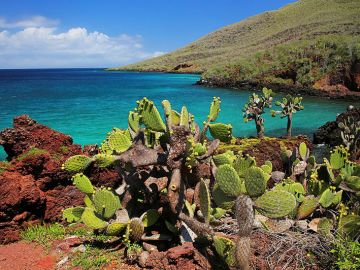
Ultimate Guide to Galapagos Islands Travel
Visiting the Galapagos Islands is like stepping into one of those BBC nature documentaries narrated by Sir David Attenborough. In this archipelago, which is located 600 miles off the coast of Ecuador, you can swim with sea lions, walk alongside the world’s largest tortoise, and explore dynamic, dramatic landscapes utterly unlike any other place on Earth.
Because of their remote location, the Galapagos Islands remained untouched for millions of years before human discovery. The most famous early explorer of the archipelago was, of course, Charles Darwin, who developed his theory of evolution by natural selection after his visit to the Galapagos in 1835.
Because approximately 97% of the archipelago is protected as part of the Galapagos Islands National Park and Marine Reserve, they still remain relatively untouched today. This is truly a nature-lovers’ haven, where unusual endemic plants and animals have adapted genetically in order to thrive. In fact, the Galapagos Islands is such a spellbinding melting pot of scientifically significant species that it was named the world’s first UNESCO World Heritage Site in 1987.
The archipelago has been capturing the imagination of travelers for centuries now, and more than 200,000 people make the journey each year. But how much do you actually know about these exceptional islands, which collectively comprise one of the most biodiverse places on the planet?
The following are 30 fascinating facts about the Galapagos Islands, including trivial tidbits on the wildlife, places to go, things to do, and lots of practical info.
Places to Visit in the Galapagos Islands
1. The Islands
The Galapagos is an archipelago of 19 islands in the Pacific Ocean. It’s located on a junction where three tectonic plates meet, and 13 of the islands are volcanic.
The archipelago is actually a result of numerous volcanic eruptions over millions of years (including 13 in the last century). The oldest island, Espanola, is estimated to be around 3.5 million years old, but many of the others are still forming. The youngest island is Fernandina, at a youthful 1 million years old.
Each island has its own unique landscapes, wildlife and activities, and only five of them are actually inhabited by people. Small communities are dotted across San Cristobal, Santa Cruz, Isabela, Floreana and Baltra. The rest of the islands are completely devoid of human presence.
By boat, you can visit uninhabited islands like Bartolome (one of the most photographed places in the Galapagos due to its stunning crescent bays and moon-like landscape), Rabida (for a red sand beach that is home to flamingos), and Isla Mosquera (a small lava reef where you can swim with sea lions). Some Galapagos cruises will incorporate trips to these uninhabited islands into the itinerary, but it is worth noting that all itineraries are controlled by the Galapagos National Park.
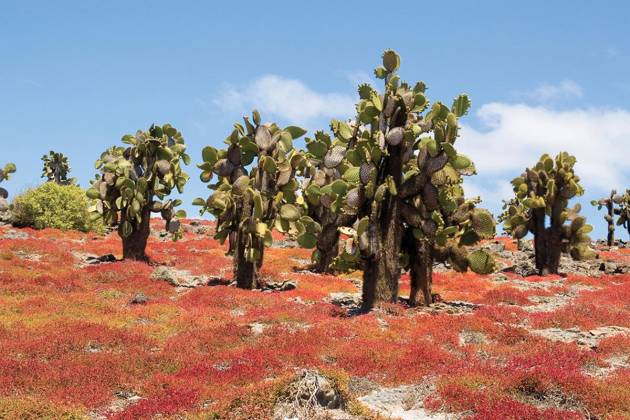
2. The Charles Darwin Research Station
The Charles Darwin Research Station is a short walk away from Puerto Ayora on Santa Cruz Island. It’s a great place to learn more about the natural history of the islands, as well as the ongoing conservation work undertaken by the Charles Darwin Foundation.
They have an exhibition hall where you can learn about 60 years of scientific research on the islands, as well as see photography exhibits and natural history collections. There’s also an enormous skeleton of a Bryde’s whale, a garden filled with native flora, a Galapagos tortoise breeding facility, and a public library with specialized books on natural sciences.
Of course, Darwin didn’t discover the Galapagos Islands. They were accidentally discovered in 1535 by a Panamanian bishop, Father Tomas Berlanga, whose ship to Peru blew off course. But Darwin’s name has been inextricably linked to the Galapagos since the 1859 publication of “On the Origin of Species,” which remains an important piece of scientific literature today.
The Charles Darwin Foundation continues his dedication to scientific research on the islands and advises the Ecuadorian government on how to protect and preserve Galapagos wildlife and natural resources.
3. Tortuga Bay
Tortuga Bay is your stereotypical postcard-perfect white powder beach. It’s located on Santa Cruz Island and is one of the most popular places for swimming and snorkeling on the island. You’ll likely have a chance to snorkel alongside fish, sea turtles, reef sharks, and marine iguanas, while boobies fly overhead and dive into the water for their dinner.
4. La Loberia
La Loberia is a small, crescent-shaped bay that’s well off the tourist trail. It’s well worth spending time here for the chance to swim alongside dozens of Galapagos sea lions and their adorable pups.
Lots of sea lions can be found dozing on the beach, and they’re comfortable enough around humans to allow you to doze nearby without concern. Sea turtles are also occasionally present in the shallows, and the water offers excellent visibility.
While you can’t touch the wildlife in the Galapagos Islands, most species are so comfortable around people that they may come close to you. However, it is advised that you make an effort to stay at least 10 feet away so you don’t disturb them. This applies even if they approach you of their own accord.

5. Volcanoes
The Galapagos is home to both extinct and active volcanoes and does have occasional eruptions. The last volcanic eruption was on Fernandina in 2018. There are 12 active volcanoes, including Pinta (which last erupted in 1928) and Marchena (which has one of the largest volcanic lakes on the islands).
Most notably, you can visit Wolf, which is the tallest volcano in the Galapagos. Located on the northern tip of Isabela Island, it stands at an imposing 1707 meters (5600 feet) high, with lava covering the floor of the caldera.
The Galapagos is also home to a series of underground tunnels, one of which is in the village of Bellavista in the Santa Cruz Highlands. You can walk through these lava tubes, which were formed by flowing lava that carved out tunnels as it moved beneath the earth’s surface.
6. The Santa Cruz Highlands
The Santa Cruz Highlands are also where you’ll find the largest population of giant Galapagos tortoises, some of whom are over a hundred years old.
The higher altitude of the region allowed the Escalesia and Miconia forests to form, and the lush vegetation and fertile soil there has created the perfect natural habitat for the species.
You’ll be able to walk (or stand, as they don’t exactly move quickly) next to scores of tortoises as they slowly navigate through the leafy undergrowth. The species was hunted nearly to the point of extinction by whalers in the 19th century, but ongoing conservation efforts managed to save the population.
The highlands are also a prime spot for bird watching. Nearly all species of birds of the Galapagos Islands have been spotted here at some point.
7. Kicker Rock
Unmistakable Kicker Rock is a popular photo stop and is included on many Galapagos Islands cruise itineraries. Fun fact: It’s also called Leon Dormido, because it is said to look like a sleeping lion.
The waters surrounding the rock can get choppy, but there is a diverse range of marine life that can be found here. You’re almost guaranteed sightings of an array of underwater animals, including sea turtles, eagle rays, Galapagos sharks and starfish.
But don’t be so captivated by the marine life below that you forget to look up. The rock is a refuge for frigate birds, and you may also see Nazca boobies.
Things to Do in the Galapagos Islands
8. Go Island Hopping (Responsibly)
With 19 islands, you won’t have time to visit them all. But one of the coolest perks of cruising the Galapagos is the ability to travel between islands. Since long distances are involved, the best way to see more of the Galapagos is by taking a cruise.
Most Galapagos cruises travel between islands at night in order to maximize your daylight time for activities. Most days will include shore landings, snorkeling opportunities, and Zodiac rides to smaller islands that land-based tourists usually can’t visit.
9. Snorkeling and Scuba Diving
The Galapagos Islands are considered one of the top destinations in the world for snorkeling and Scuba diving. The waters throughout the archipelago are absolutely teeming with marine life, most of which can’t be found anywhere else. With crystal clear water pretty much all year round, the high levels of visibility ensure stunning sightings.
There are around 30 prime dive sites in the Galapagos (including hotspots like Darwin’s Arch, Shark Point, and Gordon Rocks), but you can snorkel almost anywhere.
While anyone can snorkel without certification, it’s important to be aware of the strong currents that run through the Pacific. If you’re snorkeling in the ocean, always use the buddy system. And don’t forget to bring an underwater camera, as marine animals are likely to come right in front of you!
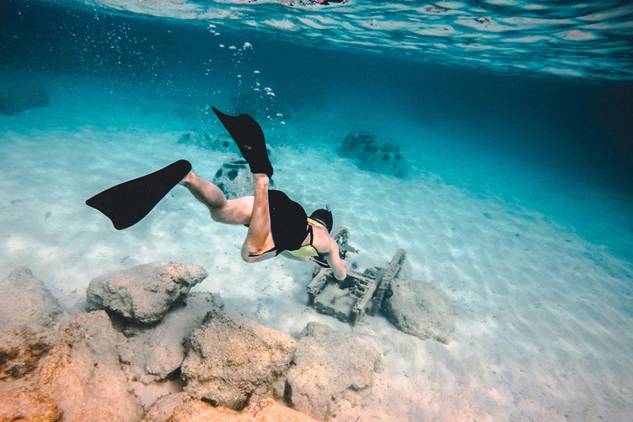
10. Photograph Wildlife
Photography is on most people’s minds when they visit the Galapagos, with everyone hoping for photos worthy of National Geographic’s “Your Shot.” And while the islands’ landscapes are undoubtedly stunning, it’s the opportunity for snapping unique wildlife portraits that attract most photographers.
Most Galapagos Islands animals have no fear of close proximity to humans. So you’ll easily get close up shots of Galapagos sea lions, marine iguanas, giant tortoises, and birds. Some may even approach so closely that you’ll have to back up in order to get their whole body in the shot!
But it’s important to remember not to disturb them or try to coerce them into moving into a more suitable position for your shot. If they look uncomfortable, it’s best to back away. If you’re spending much time at the beach (which you should), remember to pack zip locks or dry bags to keep your equipment sand-free.
11. Birdwatching
The entire Galapagos archipelago is a protected sanctuary for an array of weird and wonderful wildlife. That includes 56 different species of native birds (45 of which are endemic and only exist in the Galapagos).
Look to the land, sea, and sky for a range of sea birds, shorebirds and migratory species.
Even those who don’t normally consider themselves interested in birds will be fascinated by the blue-footed boobies, American flamingos, Galapagos penguins and puffed-up red throat pouches of the male frigate bird.
12. Hiking
With 97% of the Galapagos protected as national park, it’s no surprise that there are many exceptional hiking trails throughout the islands.
Note that not all of the islands can be explored by visitors. But there are many opportunities for hiking through varied terrain, from blackened lava rock trails to coastal beach walks and exploration of the lush, green highlands.
One of the most popular hikes in the Galapagos is on the island of Sante Fe, where you can walk through a forest where the cacti grow 32 feet
If you’re planning on hiking during your time here, make sure you bring proper walking shoes, as many trails are rocky and best not attempted in flip-flops.
13. Sea Kayaking and Swimming
There are many different ways to enjoy the water in the Galapagos, and you don’t have to snorkel or Scuba dive in order to have an incredible experience. Shallow places like Gardner Bay and Tagus Cove offer the opportunity to swim alongside all kinds of wildlife.
Fascinating fact: When you’re swimming alongside the green sea turtle, think about the fact that this species is believed to have swum alongside dinosaurs some 66 million years ago!
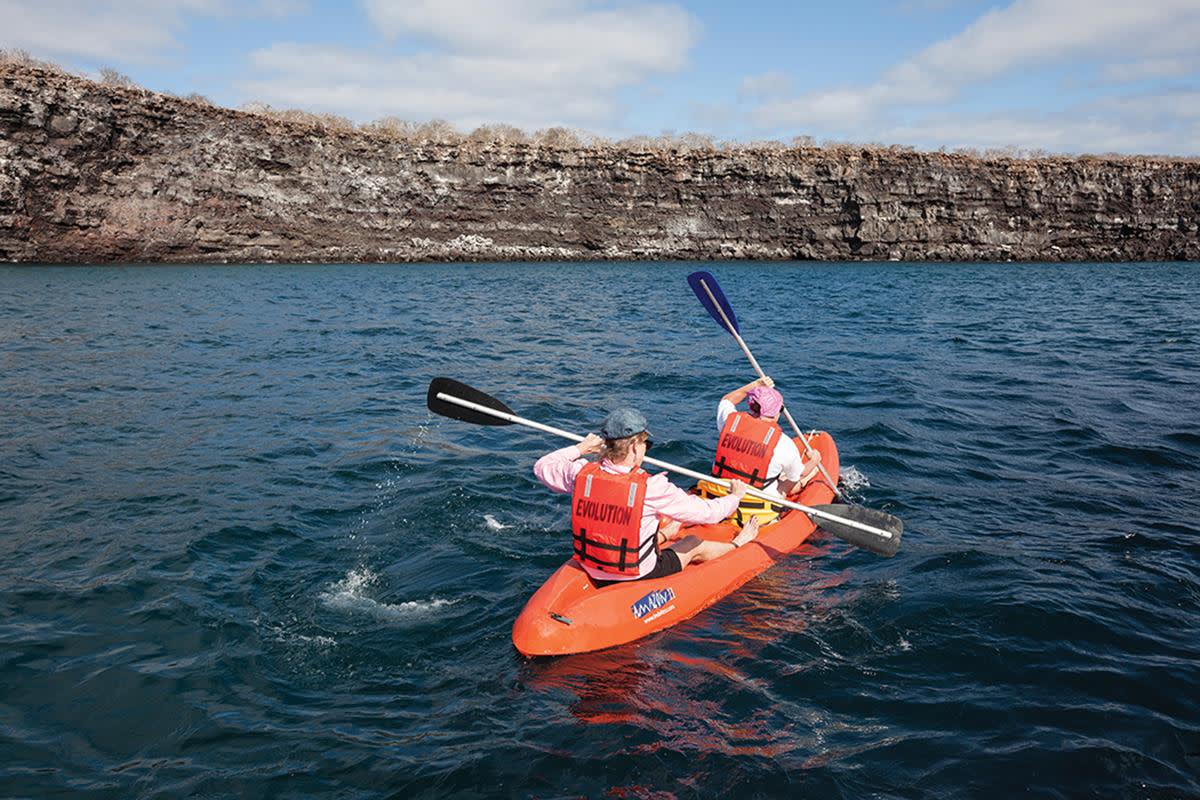
14. Beach bumming
One of the best ways to spend time in the Galapagos is simply relaxing on the beach. You’ll often find wildlife such as sea lions and marine iguanas sunning themselves on the sand right next to you. Tortuga Bay, the beach at Bartolome Island, and El Garrapatero are some of the most popular Galapagos beaches.
15. Chocolate and Coffee
The Galapagos is best known for its wildlife diversity, but it also has some interesting agriculture. Dotted throughout the islands are fincas (a.k.a. farms) that produce both chocolate and coffee.
The Galapagos has to import most of its food and water from the mainland, but coffee and chocolate are in no short supply here. Coffee plantations have operated there since 1869 when it was discovered that arabica typica coffee plants would thrive in the rich volcanic soil.
Coffee is now the islands’ biggest export. Fascinating fact: Starbucks is their biggest importer.
You can visit coffee plantations on the island of Santa Cruz, and learn about the journey of the coffee from cherry to bean to cup. Also on the island is a shop called Chocolapagos, where you can find chocolate turtles from a local chocolatier.
Wildlife in the Galapagos Islands
16. Galapagos Sharks
The Galapagos Shark is a species that was once found all over the world. But due to commercial fishing, it is thought to have gone extinct in most locations except for the Galapagos Marine Reserve.
They look similar to a reef shark but are a fairly large species that can grow up to ten feet in length. They’re most commonly seen around Wolf and Darwin Islands.
Although they’re present all year round, March and April is a great time to see juvenile sharks who have just been born. That’s when they flee to shallow waters in order to gain strength before making their way out into the ocean.
17. Blue-Footed Booby
One of the signature species of the Galapagos Islands, the blue-footed booby is a sea bird known for its distinctively colorful feet (and its fanciful mating dance).
Have you ever wondered why this booby has blue feet? It’s believed that carotenoid pigments from their diet concentrate in their feet, which results in the blue coloring. The higher concentration of pigment a bird has, the more intense the color of his feet.
While the blue-footed booby is the most famous, the Galapagos is actually home to three different types of booby (a close relation of the gannet). You should also keep an eye out for the red-footed and Nazca (a.k.a. masked) boobies. Watching them plunge from the air into the open ocean and emerge with a fish in their beak is quite the visual treat!

18. Fish
The Galapagos is home to more than 400 different species of fish, and at least 50 of these species are unique to the islands. This makes the islands a paradise for snorkelers.
19. Galapagos Penguin
The Galapagos penguin is quite the anomaly. It’s the only penguin species in the world that lives in the northern hemisphere, and breeds in the tropics above the Equator. It’s also the smallest species of penguin in South America.
Although they have adapted to the warm weather, you’ll usually find the Galapagos penguin around the western islands, as the cool currents here mean that the water temperature stays relatively low. You’ll most often see them swimming in places around Bartolome Island, or walking on land around the coastlines of Isabela and Fernandina.
20. Flightless Cormorant
Another Galapagos Island anomaly, the flightless cormorant is the largest cormorant species in the world, but the only one that is unable to fly. This genetic adaptation is due to the fact that there are no natural predators in the Galapagos to threaten them, so flying has never been necessary.
As a result, their wingspan has evolved over time to the point where it is around a third of the size that they would need if they wanted to take flight. So instead, they swim down in the ocean to feed on algae.
You’ll usually find these bizarre birds breeding on the islands of Isabela and Fernandina.
21. Magnificent Frigatebird
The magnificent frigatebird is iconic for its bright red gular sac, which inflates like a balloon during mating season. Females are larger but don’t have the same pouch the males are famous for, with a white chest instead.
Regardless of gender, both are wonderful to watch as they float effortlessly on air currents. They are known as consummate aerial artists: The Spanish nicknamed them “pirate birds” for their habit of stealing food from other birds while in midair. It’s a fitting description, as they often force other birds to regurgitate their recent feed, then catch it before it hits the ocean.
You can see frigate birds across the Galapagos Islands all year round. They are most commonly seen in breeding colonies on Floreana, San Cristobal, and North Seymour. Look for them in mangroves and deciduous trees.
22. Marine Iguanas
The Galapagos marine iguana is the only lizard in the world that swims in the ocean. They are unique to the islands, but they’re also impossible to miss.
You’ll find thousands of them across the islands (in fact, there are thought to be upwards of 300,000), though the populations on Isabela and Fernandina are the largest.
They are typically black, with a dragon-like appearance, though many males will change color when it comes time to mate. Breeding season is between January and March, and males will often turn bright red or green to attract mates.
You’ll usually find them lazing about in the sun on rocky shores, or in the water searching for seaweed and underwater algae (which they eat exclusively).
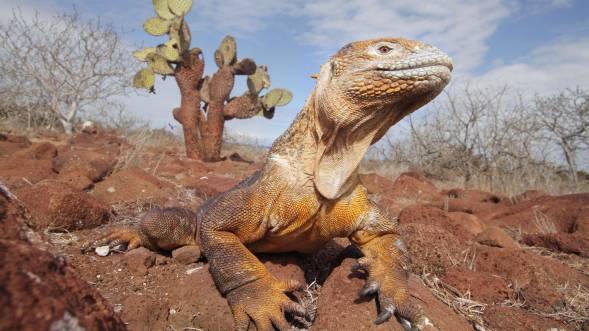
23. Galapagos Giant Tortoise
The Galapagos Islands are actually named after the giant tortoise (Galapagos in Spanish means tortoise). So naturally, these ancient-looking reptiles are one of the archipelago’s biggest draws.
This is the largest type of tortoise in the world, weighing up to 595 pounds and living for up to 170 years.
They’re believed to have arrived in the islands from the mainland some two to three million years ago. Today you can find them in the Santa Cruz Highlands as well as wandering the volcanic slopes of Alcedo.
24. Darwin’s Finches
Named for their pivotal role in Charles Darwin’s theories on evolution, there are 13 species of finches that vary throughout the Galapagos Islands.
After studying the birds for five weeks, Darwin’s theory was that all 13 had evolved from a single species on the mainland, adapting genetically to feed on the different food sources on different islands. This formed the backbone for the rest of his study, which found similar genetic diversity among the tortoise subspecies.
Darwin’s finches are easily spotted throughout the islands. Differences between the species are subtle, but they will have noticeable variances in behavior, shape, body size, and/or plumage.
25. Galapagos Sea Lions
You’ll find the Galapagos sea lion in abundance pretty much everywhere throughout the islands. In fact, they are easily the most common marine mammal in the archipelago. Head to any beach or any dock on any island, and you’re likely to encounter a sea lion sleeping or swimming close to the shore.
26. Galapagos Fur Seals
Fur seals are less common than sea lions and are rarely seen out in the ocean. But you can occasionally spot them napping among the rocks if you head to the western islands.
Their population numbers are actually similar to that of the Galapagos sea lions. But for unknown reasons they generally choose to hang out in more isolated places.
While they appear similar to the Galapagos sea lion, fur seals are smaller, their eyes bulge more, they have larger flippers (which have evolved due to their preference for rocky cliffs), and they have a much thicker coat and skin.
Practical Facts About the Galapagos Islands
27. How to Get to the Galapagos Islands
Getting to the Galapagos Islands requires flying into either Quito or Guayaquil, the biggest cities in mainland Ecuador. Both cities can easily be reached with direct flights from the United States.
Quito was recognized by UNESCO for being the best preserved and least altered historic center in all of South America. Fascinating fact: The Galapagos Islands became the world’s first World Heritage Site and Quito was #2.
28. Weather in the Galapagos
The climate in the Galapagos Islands is often dependent on the ocean currents. But there is typically very little rainfall, low humidity and relatively moderate air and water temperatures.
While the archipelago is technically located in the tropics, the climate all across the islands is very dry. You can expect the temperature to be between 68-83ºF all year round.
29. The Best Time to Visit the Galapagos Islands
With these relatively constant temperatures, the Galapagos is a year-round travel destination. But it does see two distinct seasons.
The wet season lasts from December through May: Temperatures during these months are warmer, with more rain to be expected. March and April are the hottest and wettest months. But by May the weather becomes more comfortably warm and balmy.
Most travelers choose to visit the Galapagos Islands from June through December, when it’s cooler and dryer (with August being the coolest month). If you’re traveling during this season, you may want to use a wet suit for any snorkeling activities, as the water temperature becomes a bit more “refreshing.”
If you’re traveling to the Galapagos with the sole intent of seeing a specific wildlife species, it’s best to plan your trip around that. For instance, if you’re particularly interested in seeing whales, you’ll need to time your trip to their arrival in June. If you want to see young Galapagos sea lion babies, pupping season is in August.
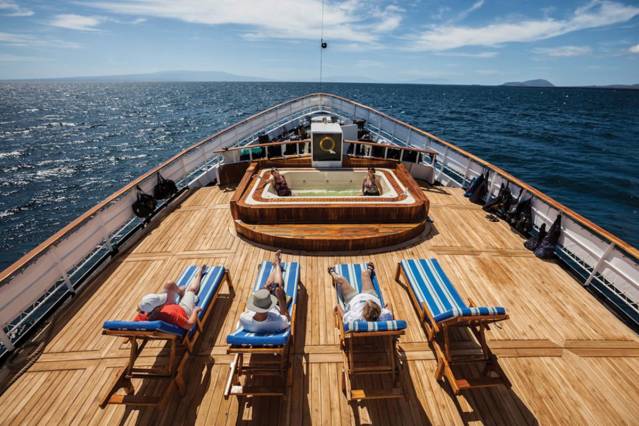
30. How to Pack for the Galapagos Islands
Because the Galapagos are so isolated, the prices on everyday items are relatively expensive, and supplies are usually limited across the islands’ few small shops. So it’s important to bring everything you need with you. Don’t expect to be able to buy it once you get there.
The official currency is the US dollar. But it’s a good idea to bring enough cash with you, as ATMs on the islands often run out. Most shops will accept credit cards, but cash is always good to have on hand for tipping.
Essentials include sturdy walking shoes for shore excursions and hiking, as you’ll often be walking over sharp volcanic rocks. Beach shoes such as sandals and flip-flops can be worn throughout the towns, or onboard your cruise ship.
You’ll also want to bring reef-safe, water-resistant sunscreen, and a lot of it. The Galapagos Islands are situated right on the Equator, which means you’ll be exposed to more intense UV rays than you might be used to at home.